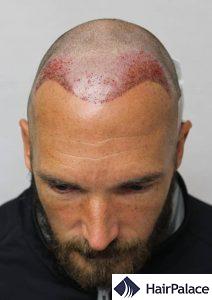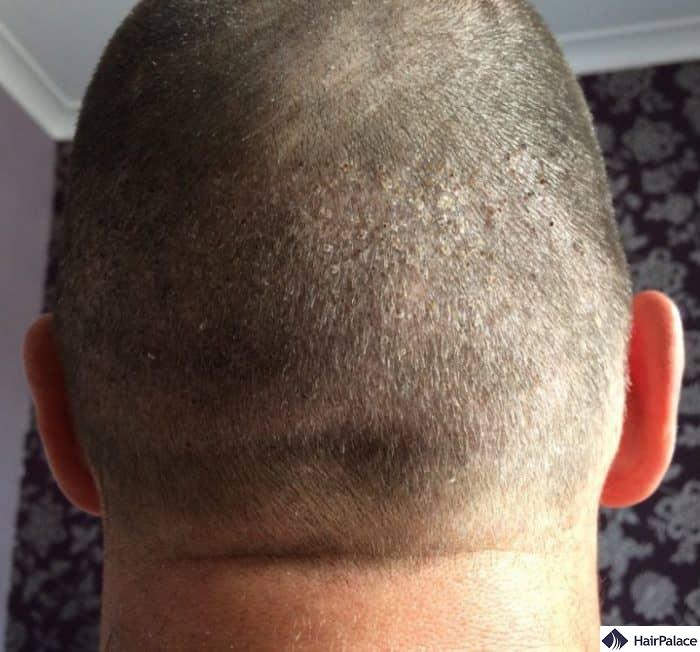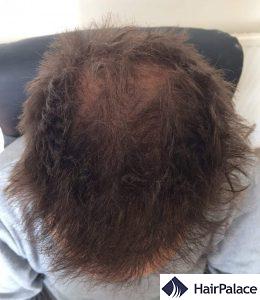Rob’s Hairline Correction
In the video above, Rob shares his account about his hair loss and his experience with the hair transplant at HairPalace clinic.
Below, we’d like to show you what happened after the surgery and how the implanted area improved through the months!
Rob got in touch with our clinic in September 2016.
He booked an appointment for a personal consultation in London for September 21st to finalise the details of his hairline correction.
The doctor examined his scalp and his donor area and found him to be a good candidate for the FUE2 hair transplant.
Hairline transplant for men
HairPalace carries out every male hairline transplant with the help of the latest FUE2 technique.
The FUE2 Safe System hairline transplant uses an advanced technique that specifically creates natural-looking, dense hairlines for men affected by male pattern baldness.
Unlike older methods, the FUE2 system uses a specialised punch with a safety mechanism that minimises trauma to the donor area and surrounding tissues.
During the procedure, the surgeon precisely extracts individual follicular units and artistically implants them along the hairline, following the natural direction and angle of hair growth.
This ensures a seamless, undetectable result.
The FUE2 Safe System also reduces the risk of follicle damage, promotes faster healing, and minimises scarring compared to traditional FUE techniques.
This type of hairline correction hair transplantation is especially effective for men who want to restore a youthful hairline with the highest precision and safety standards available today.
Rob’s hairline correction surgery
Rob explained that his goal was to fill the frontal area and build out a new hairline.
In such cases, the doctors always do a quick sketch of the hairline, as you can see below:


Although these sketches aren’t highly polished, they play a crucial role in helping the doctors estimate the number of hairs.
On the day of the surgery, the doctor perfects and finalises the hairline, and they only start the implantation once the patient is fully satisfied with the design.
The doctor proposed him 4-5000 hairs to achieve the hairline he had in mind and explained what the hair transplant would involve.
Rob let us know that he is ready to proceed in July 2017 and after taking a look at his condition once again, he booked his surgery for September.
We transplanted 5315 hairs on the 20-21st of September 2017, as shown below:

1 week after the surgery
Patients must use a sterile saline solution every hour for 1 week after the surgery.
The spray will keep the scalp clean and hydrated, and combined with the antibiotics, it will help to prevent any inflammation.
Except for the saline solution, patients must avoid letting anything touch their scalp; they must not wash it at all during the first seven days.
As a result, at the first check-up, the scabs are still visible both on the donor and the recipient areas:


After the surgery, the implanted roots will need time to make connections in the tissue in their new place. And until they anchor, they can be easily pulled out.
To prevent grafts from getting stuck or caught in textiles, patients should avoid covering their head for 3 weeks and use a neck pillow when sleeping during the initial period.
3 weeks after the hairline correction
By the 3 weeks’ checkup, the scabs must be all gone, but the redness might take longer to fade away.
As we can see in his check-up photo, some redness can be detected, but Rob soaked the scabs off properly:

Overall, after the 3 weeks’ examination, the implanted area will need less and less attention.
Patients can start exercising again, and they can shortly return to using their usual shampoo.
However, as it might still be sensitive, it is best to remain gentle with the scalp.
Since the hairs are still short, patients must wear a hat or cap when going outside in the summer to protect their scalp from sunburn.
3 months after the surgery
As the transplanted hairs start to fall out from the 4th post-op week, at the 3 month’s check-up there is not much to see.
Yet it is still important to check if the progress is going well. While usually there are not many hairs, the doctors must take a look at the condition of the scalp.
A pinkish colour and a few spots here and there are normal, especially with a bit more sensitive skin.
In these cases, the doctors may advise a gentle treatment to help them disappear quicker.
As you can see below, in Rob’s case there was only a bit of red tint on the implanted area.
Other than that, his front looks just the same as before we implanted the hairs:


6 months after the surgery
There is a striking change happening between the 3 and 6 months’ check-ups.
As the growth period starts, new hairs appear in a significant number in just a few months.
By the 6th post-op month, approximately 50% of the implanted hairs are visible.
At this point, the implanted hairs do not need any special attention. Patients can safely dye their hair, and they can naturally cut and style it any way they prefer.
Rob experienced a rapid progress too – in his photo, we can see a really good, even density at the front:

12 months after the surgery
The growth period can last until 12-15 months after the procedure – there are individual differences.
In the majority of the cases, the process ends around the 1-year mark, when we assess the outcome.
Naturally, if the doctors deem necessary, they recommend an additional checkup.
In Rob’s case, there was no need for another assessment – the transplanted hairs have grown out in great numbers:


Hairline correction surgery cost
Hairline restoration in the UK can be prohibitively expensive, with average prices for a hair transplant reaching around £7,500 and even frontal-only procedures typically costing £4,000–£6,000.
However, you don’t need to break the bank to achieve a high-quality hair transplant.
HairPalace Clinic in Budapest, Hungary, offers hairline correction surgery using the revolutionary FUE2 Safe System at exceptionally competitive rates.
By choosing our clinic, you can save up to 70% on your hair transplant expenses without compromising on quality or results.
A highly qualified surgeon with a proven track record performs every procedure, ensuring both safety and excellence.
If you’d like to find out whether you’re an ideal candidate for a hairline transplant, book a free consultation with our experienced surgeons today!

